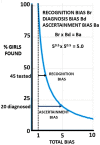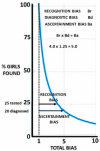Finding the True Number of Females with Autistic Spectrum Disorder by Estimating the Biases in Initial Recognition and Clinical Diagnosis
- PMID: 35204992
- PMCID: PMC8870038
- DOI: 10.3390/children9020272
Finding the True Number of Females with Autistic Spectrum Disorder by Estimating the Biases in Initial Recognition and Clinical Diagnosis
Abstract
The proportion of females whose ASD diagnosis is missed is unknown. The ratio of males to females with ASD is generally quoted as 4:1, though it is believed that there are biases preventing females from being diagnosed and that the true ratio is lower. These biases have not been clearly identified or quantified. Starting with a clinical dataset of 1711 children <18 years old, four different methods were employed in an inductive study to identify and quantify the biases and calculate the proportion of females missed. A mathematical model was constructed to compare the findings with current published data. The true male-to-female ratio appears to be 3:4. Eighty percent of females remain undiagnosed at age 18, which has serious consequences for the mental health of young women.
Keywords: autistic spectrum disorder; biases; male-to-female ratio; young women.
Conflict of interest statement
The author declares no conflict of interest.
Figures
References
-
- American Psychiatric Association . Diagnostic and Statistical Manual. 5th ed. American Psychiatric Association; Arlington, VA, USA: 2013. 54p
LinkOut - more resources
Full Text Sources






